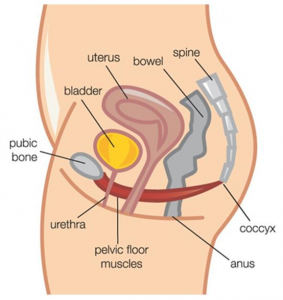The pelvic floor is a hammock of muscles between your legs which stretches from your pubic bone at the front to the base of your spine (your coccyx) at the back. Not only do these muscles support your trunk and pelvic organs (bladder, bowels and womb), but they also help control your bladder and your bowel function. In fact they hold on tight all day long to stop you leaking. When you want to go to the toilet, they relax so that you can pass urine and/or open your bowels. Then they tighten up again afterwards to restore control. If you cough, sneeze, laugh, exercise or lift something heavy, they have to hold on even tighter to withstand the additional pressure on your bladder and keep the ‘floodgates’ closed.
Why do pelvic floor muscle exercises?
When the pelvic floor muscles become damaged or stretched they may no longer work properly and/or they may no longer be able to hold up the bladder, vagina or back-passage. In some cases the muscles might be weak or damaged. In other cases it might be that they’re just not being used properly. Some women don’t know where their pelvic floor muscles are or have very little awareness of how to use them. Others think they are doing pelvic floor muscle exercises but are not doing them correctly or appropriately. Other women might have a strong pelvic floor, but are not using it when they should.
Government health guidelines recommend supervised pelvic floor muscle training to strengthen the pelvic floor in order to cure or improve a number of women’s health problems.
Who can benefit from pelvic floor exercises?
- Women who have had children (particularly difficult vaginal deliveries)
- Pregnant women
- Women who are going through the menopause or are post-menopausal
- Women with a history of constipation or bad bowel habits
- Women suffering from a chronic cough and/or hayfever
- Women who do or did a job involving heavy lifting and/or are overweight
- Women who have had certain types of gynaecological surgery




